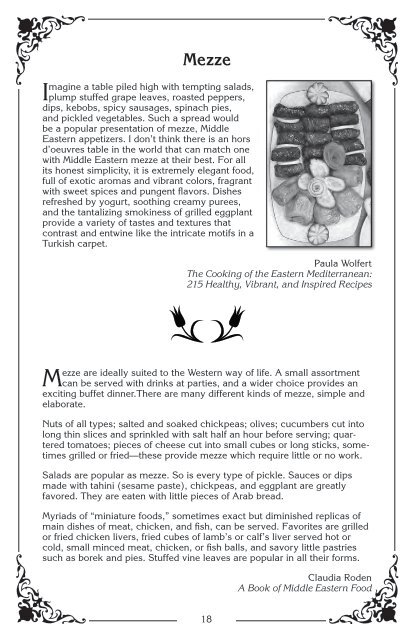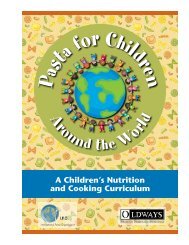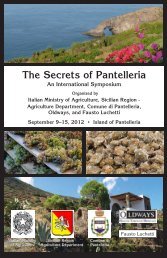Turkey's Culinary Heritage - Oldways
Turkey's Culinary Heritage - Oldways
Turkey's Culinary Heritage - Oldways
Create successful ePaper yourself
Turn your PDF publications into a flip-book with our unique Google optimized e-Paper software.
Mezze<br />
Imagine a table piled high with tempting salads,<br />
plump stuffed grape leaves, roasted peppers,<br />
dips, kebobs, spicy sausages, spinach pies,<br />
and pickled vegetables. Such a spread would<br />
be a popular presentation of mezze, Middle<br />
Eastern appetizers. I don’t think there is an hors<br />
d’oeuvres table in the world that can match one<br />
with Middle Eastern mezze at their best. For all<br />
its honest simplicity, it is extremely elegant food,<br />
full of exotic aromas and vibrant colors, fragrant<br />
with sweet spices and pungent flavors. Dishes<br />
refreshed by yogurt, soothing creamy purees,<br />
and the tantalizing smokiness of grilled eggplant<br />
provide a variety of tastes and textures that<br />
contrast and entwine like the intricate motifs in a<br />
Turkish carpet.<br />
Paula Wolfert<br />
The Cooking of the Eastern Mediterranean:<br />
215 Healthy, Vibrant, and Inspired Recipes<br />
Mezze are ideally suited to the Western way of life. A small assortment<br />
can be served with drinks at parties, and a wider choice provides an<br />
exciting buffet dinner.There are many different kinds of mezze, simple and<br />
elaborate.<br />
Nuts of all types; salted and soaked chickpeas; olives; cucumbers cut into<br />
long thin slices and sprinkled with salt half an hour before serving; quartered<br />
tomatoes; pieces of cheese cut into small cubes or long sticks, sometimes<br />
grilled or fried—these provide mezze which require little or no work.<br />
Salads are popular as mezze. So is every type of pickle. Sauces or dips<br />
made with tahini (sesame paste), chickpeas, and eggplant are greatly<br />
favored. They are eaten with little pieces of Arab bread.<br />
Myriads of “miniature foods,” sometimes exact but diminished replicas of<br />
main dishes of meat, chicken, and fish, can be served. Favorites are grilled<br />
or fried chicken livers, fried cubes of lamb’s or calf’s liver served hot or<br />
cold, small minced meat, chicken, or fish balls, and savory little pastries<br />
such as borek and pies. Stuffed vine leaves are popular in all their forms.<br />
Claudia Roden<br />
A Book of Middle Eastern Food<br />
Red Pepper Makes the Dish<br />
Pepper first came to Turkey from the Americas, and now red pepper<br />
flakes are being exported from Turkey to America.<br />
The production of red pepper flakes is a big industry in Southeastern<br />
Turkey. There are four big sites just for producing pepper in Maras. The<br />
hot red pepper is grown in the Maras plain, Islahiye plain and some also in<br />
the Adiyaman plain. During the months of August and September you will<br />
see all the fields returned to red! In Turkish food, pepper is the number one<br />
ingredient to be added to dishes. You’ll notice in nearly all the restaurants<br />
we dine, a special red pepper bowl sits on each table.<br />
There are various ways to<br />
produce red pepper flakes,<br />
but you will taste two main<br />
kinds—red and the other<br />
very dark, like purple or<br />
black.<br />
The red kind is strictly<br />
dried under the sun and<br />
then ground. The dark one<br />
is smoked, in a way. The<br />
peppers are kept in bags<br />
under strong sunshine,<br />
where they don’t get any<br />
air. Then the peppers are laid out on the hot surface of house tops in the<br />
late evening, which have really absorbed all the heat of the sun during day<br />
time. In the morning the peppers are put again in airtight bags and left under<br />
the sun. By this way, the bright color of red pepper turns to dark purple<br />
and has a smoked taste. After the peppers are completely dried, they are<br />
ground. This type of pepper is also good with bulgur dishes, especially with<br />
the always-favorite bulgur paddies. There are other methods, too, such as<br />
drying them in the oven.<br />
Red pepper paste is made from fresh red pepper which is grown towards<br />
end of August and mid September. Fresh red pepper is ground and laid under<br />
sun shine to be cooked by the strong heat of the summer sun. The juicy<br />
red pepper is stirred while it is under the sun, and after a few days it becomes<br />
a thick pepper paste, depending on the depth of the tray used. Only<br />
some salt and olive oil are added, and then the red pepper paste is stored<br />
in glass jars. The red pepper paste lasts forever, and is used for all kind of<br />
meals, especially bulgur dishes. The traditional bulgur salad—kisir—has no<br />
taste without red pepper paste!<br />
18 19<br />
Ayfer Unsal<br />
Journalist, Cookbook Author,<br />
Turkish <strong>Culinary</strong> Expert




